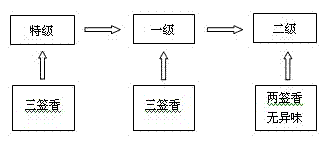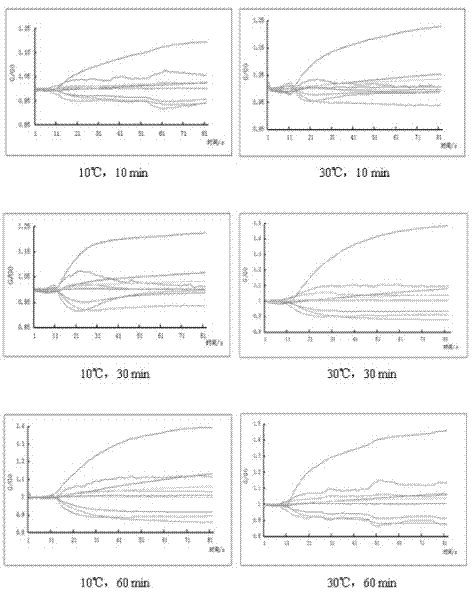Jinhua ham grading and identifying method based on electronic nose technology
A technology of Jinhua ham and electronic nose, which is applied in the field of identification of Jinhua ham and cured meat, achieves the effects of simple operation, accurate identification results, and easy popularization and application
- Summary
- Abstract
- Description
- Claims
- Application Information
AI Technical Summary
Problems solved by technology
Method used
Image
Examples
Embodiment 1
[0046] Example 1: Identification of different grades of Jinhua ham
[0047] (1) Cut extra-grade, first-class and second-class Jinhua ham into small pieces of 2 mm×2 mm×2 mm, put them in a clean 150mL beaker, and quickly seal the mouth of the cup with plastic wrap. Incubate at 30°C for 30 min. Weigh 10g of each sample, and do 10 parallel experiments for each level.
[0048] (2) After the electronic nose was initialized for 30 min, the injection needle was inserted into the beaker through the plastic wrap to absorb the headspace gas. Set the adsorption time to 80s and the cleaning time to 60s.
[0049] (3) Collect the data collected by the sensor array, and use Unscrambler software and WinMuste software to perform principal component analysis (PCA, Figure 4 ), linear discriminant analysis (LDA, Figure 5 ) and partial least squares analysis (PLS, Figure 6 ).
[0050] For PCA and LDA, each level selects 30 values between 78s-80s in the plateauing period as the pattern ...
Embodiment 2
[0056] Embodiment 2: the identification of Jinhua ham and cured meat
[0057] (1) Cut Jinhua ham and bacon into small pieces of 2mm×2mm×2 mm, place them in clean 150mL beakers, and quickly seal the mouth of the cups with plastic wrap. Incubate at 30°C for 30 min. Weigh 10g of each sample, and do 4 parallel experiments for each level of ham and bacon.
[0058] (2) After the electronic nose was initialized for 30 min, the injection needle was inserted into the beaker through the plastic wrap to absorb the headspace gas. Set the adsorption time to 80s and the cleaning time to 60s.
[0059] (3) Principal component analysis (PCA, Figure 7 ) and linear discriminant analysis (LDA, Figure 8 ).
[0060] For PCA and LDA, each level selects 30 values between 78s-80s in the plateauing period as the pattern recognition data for analysis, from Figure 7 and Figure 8 It can be seen that Jinhua ham and bacon of various grades are well distributed in different areas, indicating tha...
PUM
 Login to View More
Login to View More Abstract
Description
Claims
Application Information
 Login to View More
Login to View More - R&D
- Intellectual Property
- Life Sciences
- Materials
- Tech Scout
- Unparalleled Data Quality
- Higher Quality Content
- 60% Fewer Hallucinations
Browse by: Latest US Patents, China's latest patents, Technical Efficacy Thesaurus, Application Domain, Technology Topic, Popular Technical Reports.
© 2025 PatSnap. All rights reserved.Legal|Privacy policy|Modern Slavery Act Transparency Statement|Sitemap|About US| Contact US: help@patsnap.com



